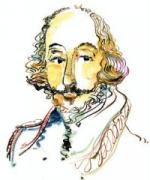|
This section contains 6,922 words (approx. 24 pages at 300 words per page) |

|
SOURCE: “‘We were born to die’: Romeo and Juliet,” in Comparative Drama, Vol. 15, No. 1, Spring 1981, pp. 54-71.
In the following essay, Carroll argues that the ending of Romeo and Juliet is announced at the beginning, and is repeatedly articulated in succeeding scenes. Pointing out significant deviations between the final scene of Romeo and Juliet and Shakespeare's principal source—The Tragicall Historye of Romeus and Juliet—Carroll proposes that Shakespeare wanted to emphasize there is no escape from the tomb for the young lovers and that the only satisfactory means of memorializing their love is through dramatic representation.
While Romeo and Juliet consummate their marriage offstage, their one night in the sheets of love is shaded by the ghostly presence of winding sheets. Tybalt's death hangs over Verona, as old Capulet says to Paris:
Look you, she lov'd her kinsman Tybalt dearly, And so did I. Well, we were...
|
This section contains 6,922 words (approx. 24 pages at 300 words per page) |

|


